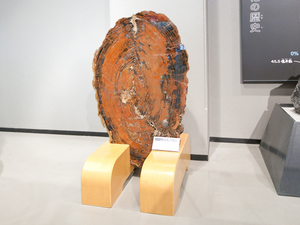Nagoya City Science Museum
TOP > Exhibition Guide > Floor Map> Evolution of Life: Life on the Land
Evolution of Life: Life on the Land



Purpose of Exhibition
With the Earth's atmospheric oxygen increasing, the ozone layer that occurred in the upper atmosphere allowed marine life to come onto the land. The exhibits are symbolic of the marine life that came onto the land.
Additional Knowledge
When a certain kind of photosynthesizing seaweed (cyanobacteria) thrived in the shallow portions of the oceans about a billion years ago, oxygen began to increase rapidly. According to some scholars, the surge in oxygen generation triggered an explosive increase of life on the Earth about 600 million years ago. Increasing atmospheric oxygen reached a sufficient level to form the ozone layer in the upper atmosphere, and the ozone layer prevented harmful ultraviolet rays from reaching the Earth's surface approximately 400 million years ago. Cited as evidence are the discoveries of numerous fern fossils and land animals' footprints in the waterfront stratums.
Life gradually came onto the land, starting about 400 million years ago. Presumably, huge fern forests had already been formed 300 million years ago. It is evidenced by the discoveries of coals, which are the fossils of trees. In addition, a host of leaf fossils were discovered. Such natural underground storage of huge volumes of organic matters is considered to have played a major role in reducing the atmospheric carbon dioxide. This means that mankind, thereafter, began to go out of its way to mine the naturally underground-stored non-oxidized organic matters (coals) for use as fuels. Some 230 million years ago, huge gymnosperm forests had already been formed. On exhibit here is a slice of the trunk of silicified wood, a gymnosperm. There is something quite mysterious about silicified wood whose trunks turned, with annual growth rings but without any change in shape, into agate and/or opal. The Petrified Forest National Park in Arizona, U.S.A. is abundant in silicified wood.
What is presumable from the early inhabitation of reptiles in that era is that a habitat similar to that in this day and age had already been formed.
Those fossils evidence not only the inhabitation of those living things but also the formation of the ozone layer.
Article by Shoji Nishimoto, curator
